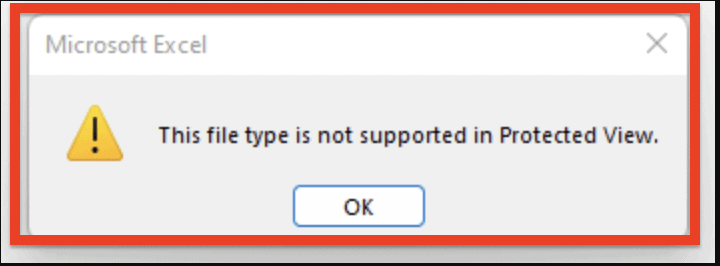“This File Type Is Not Supported In Protected View” – if you’re an avid user of Microsoft Excel, you might have come across this error at least once.
This error can be extremely frustrating, especially when you have an important file to work on.
But don’t worry, you’re not alone.
This error is a common issue among Microsoft Excel users, and it’s not difficult to fix.
In this article, we’ll delve into the reasons why this error occurs and provide step-by-step solutions that you can follow to solve it.
What Causes “This File Type Is Not Supported In Protected View” On Microsoft Excel
There can be two main reasons why you might be encountering this error in Microsoft Excel.
The first reason is due to the file having enabled Protected View, and the second reason could be due to the incorrect configuration of the File Block settings.
This error can occur in any operating system, including Windows, Apple, and Linux, and is mostly seen in the latest version of Excel developed by Microsoft.

How To Fix “This File Type Is Not Supported In Protected View” On Microsoft Excel
Now that you have been able to grasp the reasons why your Excel file might be showing you this error, “this file type is not supported in protected view”, it is now time to look at the solutions that you can use to solve the issue.
1. Configure File Block Settings
The first solution that you can try is to change the configuration of your File Block.
Just follow the steps below to do it easily.
Step 1: Open your Excel and then go to File.
Step 2: Scroll to the bottom and select Options.
Step 3: Now, go to the Trust Centre and then Trust center settings.
Step 4: go to File Block settings and uncheck the files given below.
- Excel 4 Workbooks
- Excel 4 Worksheets
- Excel 3 Worksheets
- Excel 2 Worksheets
- Excel 4 Macrosheets and Add-in Files
- Excel 3 Macrosheets and Add-in Files
- Excel 2 Macrosheets and Add-in Files
Step 5: Now, click on OK and save the changes.
And with this, you are done changing the configuration settings for your Microsoft excel.
Also, after this you might need to restart the computer to update your Registry.
It is best that you close your Microsoft Office then restart the computer and after that open the Microsoft Office again.
After you are done, now you should be able to access your protected files normally.
2. Disable Protected View Settings
You should also make sure that you have disabled your Protected view setting for Microsoft Excel when you are seeing the problem “this file type is not supported in protected view” occurring in your computer.
To do that please follow the given steps below.
- Open Excel and go to File.
- Click on Options.
- Go to Trust Center Settings.
- Navigate to File Block Settings.
- Uncheck all boxes.
- Click OK and save the changes.
3. Disable File Block Settings
You can also try disabling the File Block Settings to resolve this error. Follow these steps:
- Open Excel and go to File.
- Scroll to the bottom and select Options.
- Go to the Trust Center and then Trust Center Settings.
- Go to File Block Settings and disable it.
- Click OK and save the changes.
3. Repair Microsoft Office
If none of the above solutions work, you can try repairing Microsoft Office. To do that, follow these steps:
- Close all Office applications.
- Go to Control Panel.
- Click on Programs and Features.
- Right-click on Microsoft Office and select Change.
- Select Repair and follow the on-screen instructions.
4. Change The File Name And Type
Another solution that you can try is to change the File name and type.
You can rename the file by right clicking on it and then selecting Rename.
To change its type you can just put the type you want, such as ‘.xlsx’ after the file name. Doing this will make the file change both its name and its type.
Make sure that you put ‘.xlsx’ after the file because it is the file type for the latest Microsoft Excel.
5. Contact Microsoft Support Team
After you have tried all these solutions given above and still you can not open your Excel document or edit it then it is time for you to contact the Microsoft Support Team.
We recommend that you get your issue checked out by a professional as they will be able to solve the error in your system.

